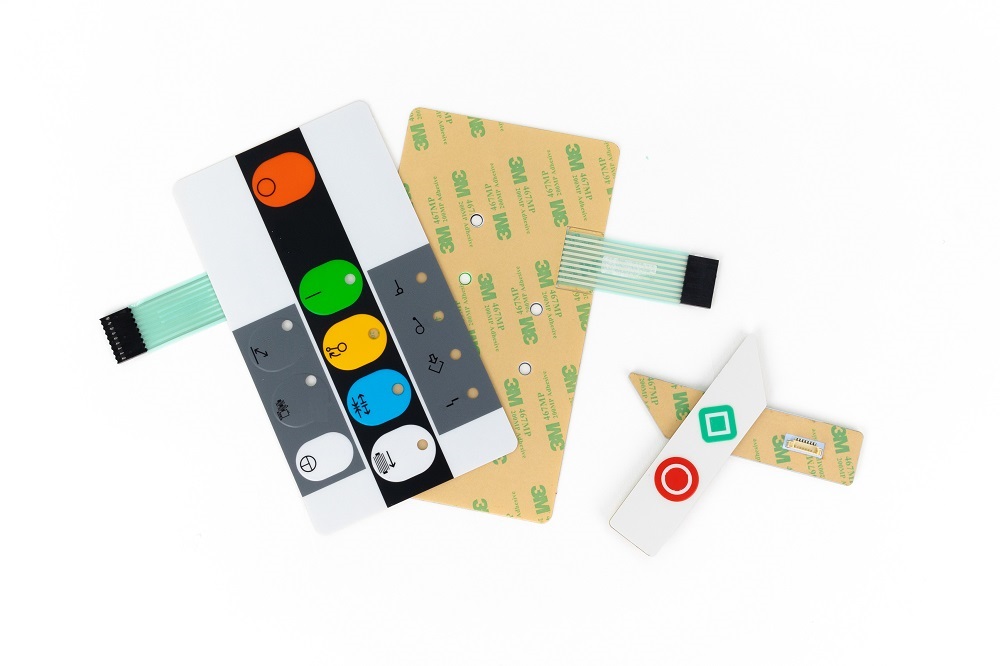Membrane Switch: Reliable, Cost-Effective, and User-Friendly Control Systems
Membrane Switch: Reliable, Cost-Effective, and User-Friendly Control Systems
Blog Article
Comprehending Membrane Layer Switches Over: The Trick to Durable and Trustworthy Controls

What Are Membrane Layer Buttons?
Membrane switches are an advanced solution in the world of customer interface modern technology, combining functionality and design effortlessly. These tools function as an interface in between individuals and digital systems, incorporating a number of components into a small layout. Normally built from versatile, slim layers of materials, membrane buttons are made to react to touch, making it possible for individuals to interact with equipment and digital devices properly.
The primary elements of a membrane layer switch consist of a printed circuit layer, graphic overlay, and a spacer layer that avoids unintended activation. The visuals overlay can be customized to show brand name identification or individual choices, improving appearances while making certain usability. Membrane buttons are typically utilized in different applications, consisting of medical devices, customer electronic devices, and industrial devices, owing to their toughness and resistance to environmental elements such as dampness and dust.
Among the key advantages of membrane switches is their capability to endure deterioration, making them perfect for high-traffic environments. In addition, they are light-weight and require marginal area, enabling ingenious designs in item development. On the whole, membrane switches represent a practical and reliable choice for modern-day electronic interfaces, marrying innovation with user-centric design principles.
Exactly How Membrane Switches Job
The operation of membrane layer switches over joints on an easy yet efficient device that converts user input into electronic signals. When a customer presses the button, the leading layer deforms, allowing a conductive aspect in the circuit layer to make call with an equivalent conductive pad on the underside of the graphic overlay.
The design of membrane switches can vary, however they often incorporate domes or tactile aspects to supply responses to the customer, boosting the overall experience - membrane switch. The materials used in membrane switches, such as polyester or polycarbonate, add to their longevity and resistance to ecological variables, consisting of moisture and dirt. The printed circuits are usually encapsulated, which secures them from wear and tear over time.
Advantages of Membrane Switches

Furthermore, membrane layer buttons are recognized for their sturdiness. Built from durable products, they are immune to dirt, dampness, and physical wear, which dramatically extends their life expectancy compared to traditional mechanical switches. This resilience makes them particularly suitable for high-traffic atmospheres and applications needing durability.
One more substantial advantage is the ease of cleaning and maintenance. The smooth surface of membrane switches over decreases dirt buildup and is often unsusceptible spills, making them ideal for setups that call for regular sanitization.
Furthermore, membrane switches provide a streamlined profile, leading to a thinner design that can be incorporated right into different devices without adding bulk. This feature not just boosts the visual allure but additionally adds to a more ergonomic product layout.
Applications of Membrane Layer Switches
Easy to use and versatile, membrane layer switches locate applications throughout a vast array of industries, consisting of medical tools, consumer electronic devices, and commercial equipment. In the clinical field, these buttons are essential to tools such as diagnostic equipment, individual tracking systems, and mixture pumps, where dependability and ease of cleansing are important. Their capability to stand up to extreme atmospheres and maintain capability makes them optimal for such applications.

In consumer electronics, membrane switches are used in items like microwaves, cleaning machines, and remotes - membrane switch. Their sleek design allows for instinctive interface, improving the overall customer experience while providing longevity and resistance to tear and use
Commercial equipment also takes advantage of membrane layer buttons, particularly in control panels for equipment and automation systems. look at this now These switches provide defense versus dirt and moisture, making sure regular efficiency in tough environments. Moreover, their personalized attributes permit manufacturers to tailor them to particular operational requirements, improving effectiveness and performance.
Selecting the Right Membrane Layer Change
When choosing a membrane switch, it is important to think about various factors that influence efficiency and viability for certain applications. The main considerations include ecological problems, tactile feedback, resilience, and design requirements.
First, analyze the operating atmosphere; switches exposed to dampness, chemicals, or severe temperatures require details materials to guarantee longevity and capability. Next, evaluate the demand for tactile feedback. Relying on individual interaction, some applications might gain from a tactile feedback to verify activation, while others may choose a non-tactile style for visual factors.
Resilience is another important element; membrane layer switches should be created to endure constant use, influences, and abrasion. Guarantee the picked button can endure the expected lifecycle, particularly in high-usage situations.

Final Thought
In final thought, membrane layer switches serve as crucial components in the style of trustworthy and durable control systems across different sectors. The versatility of membrane changes permits for customized solutions that meet particular functional demands, enhancing their significance in modern technology.
Membrane changes stand for an essential aspect of modern interface design, blending Continue functionality with durability in different applications.Membrane switches are an advanced option in the world of individual interface modern technology, incorporating capability and layout flawlessly. Typically constructed from flexible, slim layers of products, membrane layer visit the website buttons are created to react to touch, allowing individuals to communicate with machinery and electronic devices effectively.
The layout of membrane layer buttons can vary, but they frequently incorporate domes or tactile elements to provide feedback to the user, boosting the total experience.In final thought, membrane switches serve as crucial elements in the design of sturdy and reputable control systems across various industries.
Report this page